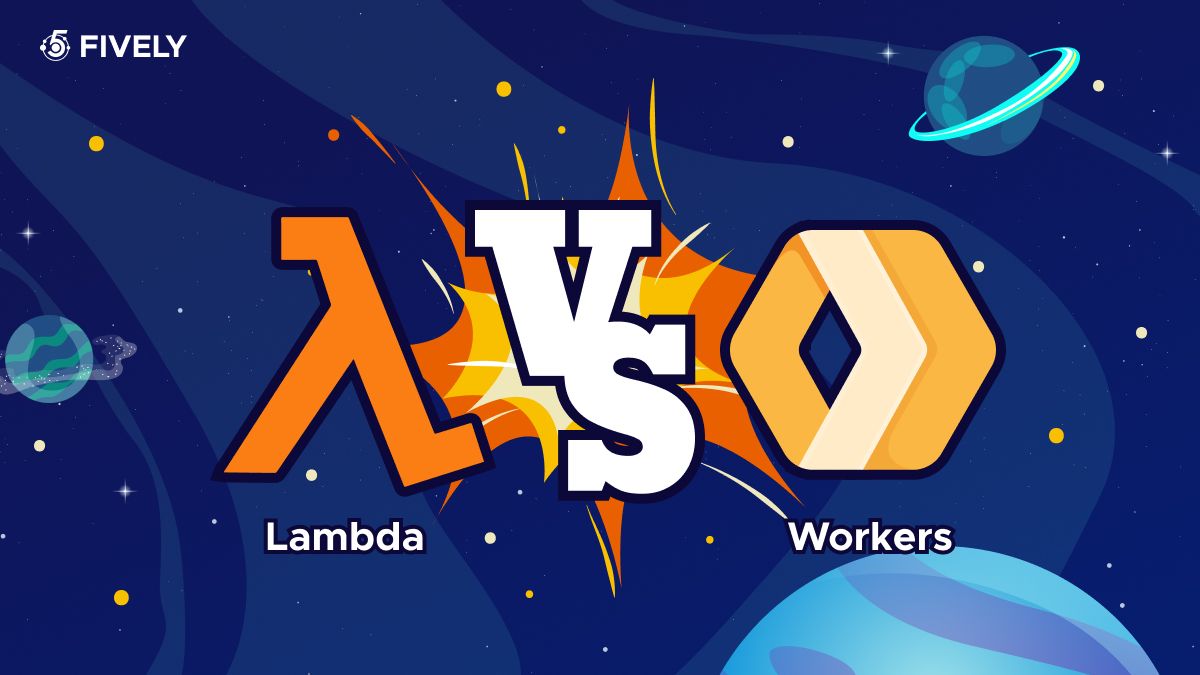Clash of the Serverless Titans: AWS Lambda vs. Cloudflare Workers Detailed Comparison
Explore the strengths and weaknesses of AWS Lambda and Cloudflare Workers in this in-depth comparison and determine which serverless platform best fits your development needs.
In my new article, as we continue our adventure into the world of Lambdas, I’d like to compare AWS Lambda and Cloudflare Workers, based on their theoretical capabilities and my practical experience. While both platforms offer serverless environments and allow developers to execute their functions without managing servers, they differ significantly across various aspects.
I'd like to explore these differences across several key categories such as performance, runtime, language support, pricing, resources used, integrations available, and, of course, imitations. Plus, I'll share my insights about which platform stands out, and also give you a cold start comparison to illustrate the differences.

It’s worth mentioning that we will compare these platforms on relatively small tasks because Cloudflare Workers (in contrast with AWS Lambda) can’t be used on heavy workloads. Let’s start.
The Essence of AWS Lambda and Cloudflare Workers
First, let’s start with a short course of theory and look at how these two platforms work.
Cloudflare Workers are service workers that manage HTTP traffic within the Cloudflare ecosystem. Designed to intercept and manipulate HTTP requests destined for your domain, Cloudflare Workers allow you to handle web requests directly on the edge of the network, providing the flexibility to respond with any valid HTTP output.
This capability enables virtually unlimited possibilities, as you can program the workers to perform a wide range of web tasks, from modifying requests to making external API calls.
AWS Lambda, on the other hand, is a serverless computing service provided by Amazon Web Services that executes your code in response to events and automatically manages the computing resources required.
Lambda can be integrated into numerous AWS services to add custom functionalities, such as processing data as it enters Amazon DynamoDB, modifying files as they are uploaded to Amazon S3, or implementing custom logic for API calls within the AWS ecosystem. Lambda ensures high availability by operating across multiple Availability Zones, and its performance does not depend on the reuse of the execution environment, although it can benefit from it.
Both platforms offer unique advantages and capabilities, making them suitable for different types of applications depending on the needs and strategies of the developer. AWS Lambda excels in integrating and enhancing other AWS services, while Cloudflare Workers offer real-time data manipulation at the network edge.
AWS Lambda vs. Cloudflare Workers: Key Comparison Parameters
Now, let’s compare both services by core metrics such as performance, runtime, language support, pricing, tools, ecosystem, and limitations.
Performance
Winner: it depends.
As you know, most serverless platforms initialize a container upon the first request and reuse it for subsequent requests until a period of inactivity leads to its termination. This initialization phase, known as the "cold start problem," introduces a delay before the function is ready to execute.
AWS Lambda operates by running code inside containers based on Node.js. This configuration can sometimes lead to latency issues known as "cold starts," where there's a delay before the function executes while the environment initializes.
Cloudflare has adopted a unique approach to address this issue. They claim to achieve virtually instantaneous function starts, or "0ms cold starts," globally. This is made possible by utilizing the Chrome V8 Engine, which powers their Workers’ runtime. This engine efficiently executes JavaScript by employing "isolates," which sandbox processes to securely run code from different users within a single process without significant overhead.
Moreover, Cloudflare Workers are hosted on Cloudflare's extensive global network, which ensures reduced latency worldwide due to the geographical proximity of the code to the end-user. The use of Anycast technology ensures that incoming requests are directed to the nearest data center, reducing latency substantially compared to traditional serverless platforms where new endpoints must be established in each location to minimize latency globally.
In contrast, to achieve minimal latency with AWS Lambda, both the function and the client need to be located in the same AWS region, which can limit flexibility in some scenarios.
So, let’s see how both serverless platforms perform while they work as a proxy function that uploads the file to S3.
- First Cloudflare Worker upload time: 838.00 ms (no cold start)
- First AWS Lambda upload time: 1519.50 ms (cold start)
- Average Cloudflare Worker upload time: 682.14 ms
- Average AWS Lambda upload time: 434.51 ms
Here, AWS Lambda wins. But, the first load in the Cloudflare Worker was 838 ms, and in AWS Lambda, due to a cold start, it was as much as 2.3 seconds.
Let’s now retest their performance as there's no cold start already:
- Average Cloudflare Worker upload time: 655.40 ms
- Average AWS Lambda upload time: 554.75 ms
As you can see, AWS Lambda wins again. But Cloudflare Workers wins in terms of startup time.
This, again, proves that there is no such thing as a cold start when you deal with Cloudflare Worker, and if an infrequent operation needs to be carried out once, then it wins over AWS Lambda. But if you pull the AWS Lambda often, it is faster than the Cloudflare Worker.
Summing up, if we are dealing with a cold start, then AWS Lambda is definitely slower because there is a cold start which can add a second or even more. If there are no cold starts (for example, there is constant loading or rare cold starts are not so important), then AWS Lambda is faster, especially since we can configure its power/hardware.
Runtime & Language Support
AWS Lambda offers native support for Java, PowerShell, Node.js, C#, Python, and Ruby, catering to a diverse development community. Cloudflare Workers, however, supports only JavaScript, Python, and TypeScript, and also allows the use of WebAssembly (WASM) compiled languages, although implementing these can be complex.
We can say that AWS Lambda obviously wins, but Lambdas are most often written based on Node.js or Python, therefore Cloudflare Workers is almost equal to AWS in this category.
Configurability and Limitations
Winner: AWS Lambda.
AWS Lambda provides significant flexibility in terms of configuration options. Users can select custom runtimes through Lambda Layers and can adjust memory allocation from 128MB to a substantial 10GB.
Additionally, Lambda functions can run for up to 900 seconds (15 minutes), which is considerably longer than the maximum execution time of 30 seconds for Cloudflare Workers. Another limitation of Cloudflare Workers is that they are not based on Node.js, which means they do not support packages that require Node dependencies. In contrast, AWS Lambda supports a broader range of dependencies and configurations, making it more versatile for complex applications.
Given these aspects, AWS Lambda is considered more advantageous in terms of configurability and support for long-running processes.
Pricing
Winner: Cloudflare Workers.
- AWS Lambda charges $0.20 per 1 million requests and about $16.67 per million GB-seconds for function execution.
- Cloudflare Workers offer a lower rate at $0.15 per 1 million requests and $12.50 per million GB-seconds.
Thus, Cloudflare Workers emerge as a more budget-friendly option in this pricing comparison, especially for projects with high request volumes and significant compute time.
You can read more about pricing in this blog post.
Tools and Resources
Winner: AWS Lambda.
AWS Lambda, launched in 2014, is often recognized as a forerunner in the serverless computing arena. Over the years, it has got a robust set of tools and resources, supported by both Amazon and a vibrant third-party ecosystem. This extensive support includes a variety of management and deployment tools that enhance the user experience and streamline processes.
In contrast, Cloudflare Workers, introduced in 2018, while steadily growing, currently offers fewer tools and technical resources compared to AWS Lambda. This makes AWS Lambda more resource-rich for developers looking for diverse tools and extensive community support.
In this category, AWS Lambda has the edge due to its maturity and broader range of developer tools and resources.
Ecosystem and Integrations
Winner: AWS Lambda.
AWS Lambda seamlessly integrates with a multitude of other AWS services, allowing for extensive versatility in application scenarios. It can interact with AWS databases, trigger functions based on events in other AWS services, and serve a myriad of use cases—from API backends to data processing engines. Conversely, Cloudflare Workers, primarily focused on web applications and edge computing, presents a narrower range of integration options. While it supports features like Worker KV and Durable Objects for stateful applications at the edge, the scope of integration is much less diverse compared to the expansive AWS ecosystem.
With its deep integration capabilities and the breadth of use cases it supports, AWS Lambda is the clear winner in this category.
Let’s now look at what we’ve got in the table below:
Conclusion
In this analysis, I've delved into the nuances of two leading serverless platforms - AWS Lambda and Cloudflare Workers - based on my personal experiences and observations. It's important to note that there is no one-size-fits-all answer when deciding which platform is superior. The choice largely depends on specific use cases and individual preferences.
While AWS Lambda is often seen as the more robust option for a variety of applications due to its extensive integration capabilities and broader language support, it has a well-known cold start delay, while Cloudflare Workers excels in scenarios that demand minimal latency on a global scale.
To my mind, particularly noteworthy is Cloudflare Workers' approach to the cold start problem, where they stand out with virtually no delays, making them a promising option for performance-sensitive environments.
I encourage you to share your thoughts and experiences regarding these platforms. Whether you agree or disagree, your feedback is valuable. Please feel free to leave a comment on this article or discuss this further on my LinkedIn page.
Also, if you need professional Cloud development services or any related help, feel free to contact Fively - our experienced engineering team is here to help your business thrive and ensure that your serverless apps work seamlessly.

Need Help With A Project?
Drop us a line, let’s arrange a discussion















